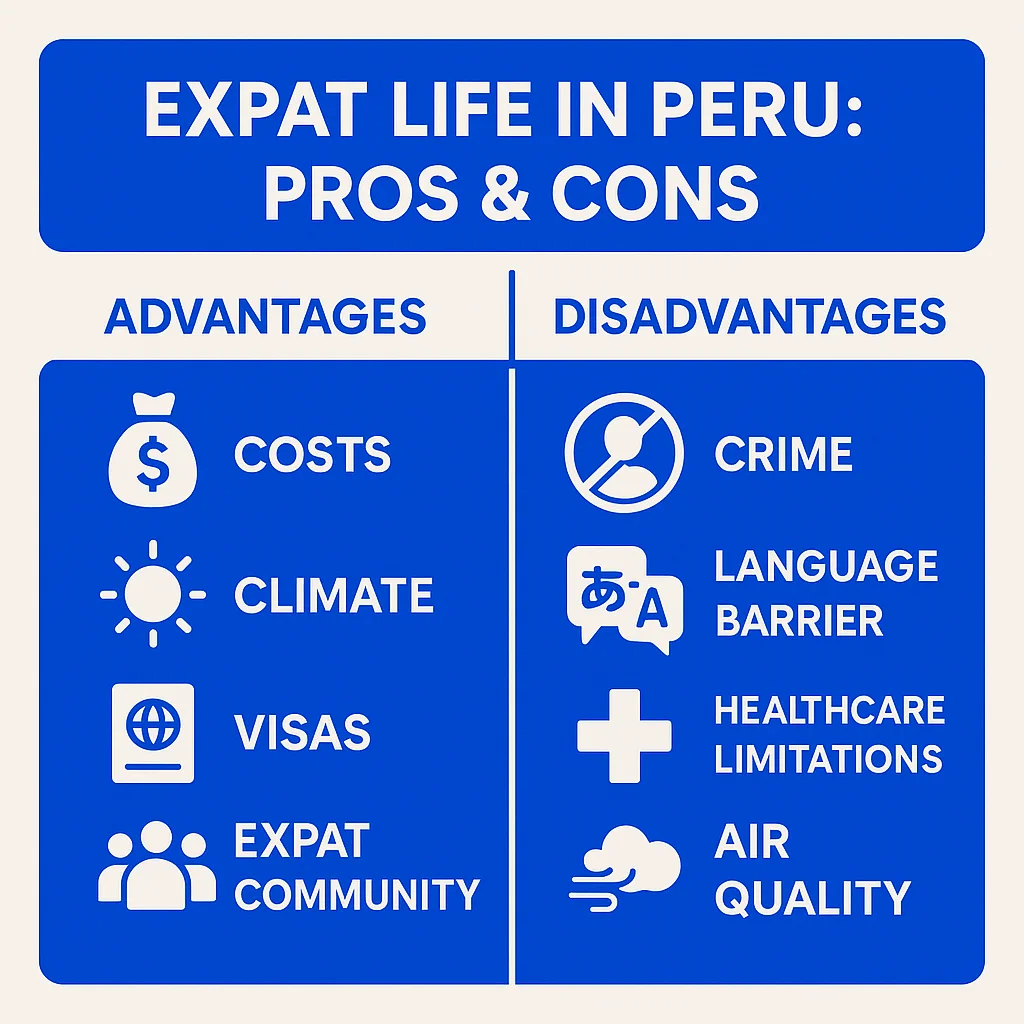Peru for Expats in 2025 - Complete Analysis of Pros and Cons

Peru has emerged as a compelling destination for international expatriates, with 875,000 registered foreign residents as of 2023—a 50% increase from 2022 data according to Peru's National Migration Observatory. This comprehensive analysis examines the real advantages and challenges of expatriate life in Peru, based on current statistics and firsthand experiences from the growing expat community.
Jungle Synergy Project
Amazon preservation initiative focused on sustainable development and biodiversity conservation.
Explore projectAbout Weles Group
Learn about our mission, values, and commitment to sustainable development in Peru.
Discover moreAmazon Retreat Centers
Why building a retreat center in the Amazon is a transformative opportunity.
Read articleInformation Asymmetry
Understanding information gaps in South American markets and opportunities.
Learn moreCost of Living: Exceptional Value with Strategic Considerations
Monthly living costs for expatriates range from $1,062 for singles to $2,413 for families of four, positioning Peru as 87% cheaper than most global destinations according to Expatistan. The cost advantage becomes particularly pronounced when comparing specific categories.
Housing represents the most significant savings opportunity. Monthly rent for furnished accommodations in Lima ranges from $251 for studios in normal areas to $792 in premium districts. Outside Lima, these costs drop by an additional 20-30%, with Arequipa emerging as the most cost-effective option according to recent Armenian Lawyer analysis.
Daily expenses offer substantial relief from Western budgets. Grocery costs typically range $150-250 monthly, compared to $350-550 in the United States. Local transportation maintains exceptional affordability at $0.50-1.00 per bus fare, while comprehensive monthly transport passes cost approximately $50.
Healthcare costs present mixed scenarios. Private medical consultations average $30 for 15-minute visits, while prescription medications remain significantly cheaper than North American equivalents. However, comprehensive international health insurance averages $4,213 annually for individuals and $12,463 for families.
Geographic Advantages: Climate Diversity and Natural Beauty
Peru's geographical diversity provides expatriates with three distinct climate zones accommodating various preferences. The coastal desert climate of Lima offers stable temperatures year-round but limited sunshine. The high desert environment of Arequipa provides 300+ sunny days annually with pleasant temperatures. Meanwhile, Cusco's high-altitude setting (11,200 feet) delivers cool mountain weather appealing to those seeking temperate conditions.
Natural attractions enhance quality of life significantly. Proximity to Machu Picchu, the Amazon rainforest, and Pacific coastline creates unparalleled recreational opportunities. The Colca Canyon near Arequipa ranks among the world's deepest gorges, while Lima's coastal location provides year-round access to beaches and water sports.
Visa and Residency: Streamlined Processes with Clear Requirements
Peru offers generous visa-free access to citizens from the United States, European Union countries, Canada, Australia, and most South American nations. Visitors can receive stays ranging from 30 to 183 days upon arrival, with officers exercising discretionary authority based on travel purpose.
Permanent residency pathways accommodate various expatriate profiles.
Investment visas require minimum capital commitments, while retirement visas cater
to pension-receiving individuals. Remote worker opportunities have expanded following
global digitalization trends, according to the U.S. State Department travel information.
Documentation requirements remain straightforward but strict. Passports
must maintain
six-month validity beyond departure dates—a non-negotiable requirement
enforced by immigration authorities. This applies regardless of nationality or
intended length of stay.
Healthcare Infrastructure: Mixed Public-Private System
Peru operates a dual healthcare system combining public EsSalud coverage with private alternatives. Foreign employees receive mandatory EsSalud enrollment through employers, contributing 9% of monthly salaries. This system covers spouses and children under 18 automatically.
Private healthcare facilities concentrate in major cities like Lima, Cusco, and Arequipa. These facilities offer modern equipment, bilingual staff, and immediate appointment availability—typically 20-30% more expensive than public options but still affordable by international standards.
Self-employed expatriates and retirees must secure private international health insurance. The public system, while accessible, suffers from underfunding and extended waiting periods. Rural areas particularly lack adequate medical infrastructure, making comprehensive insurance essential for expat families.
Peru Investor Visa Guide
Complete guide for obtaining an investor visa in Peru for 2025, including requirements and step-by-step process.
Read full guideBest Expat Destinations 2025
Top South American countries and cities for expats in 2025, featuring lifestyle, cost, and opportunity analysis.
Explore destinationsSecurity Challenges: Urban Crime and Practical Precautions
Crime statistics present sobering realities for expatriate safety planning. Lima experiences an average of 11 muggings reported hourly, while over 4,000 phones are stolen daily countrywide according to U.S. Embassy security advisories. The capital registered over 500 murders from January to October 2021.
Petty crime dominates expatriate security concerns. Pickpocketing, purse snatching, and phone theft occur frequently in tourist areas like Miraflores and Barranco. Motorcycle-based "snatch and run" operations have become increasingly common, with criminals using delivery service disguises.
Regional variation affects safety significantly. The U.S. State Department maintains Peru at Level 2: Exercise Increased Caution due to crime and civil unrest risks. However, cities like Arequipa report notably lower crime rates, with expatriate communities describing it as feeling more secure than other Latin American destinations.
Language and Cultural Integration
Spanish proficiency significantly impacts expatriate success in Peru. While major cities host English-speaking communities, daily interactions require Spanish skills. The language barrier affects everything from healthcare navigation to government bureaucracy.
Cultural adaptation involves understanding indigenous influences alongside Spanish colonial heritage. Peru's population maintains strong connections to Quechua and Aymara traditions, particularly in highland regions around Cusco and rural areas.
Economic Opportunities: Employment and Business Environment
Employment opportunities for expatriates concentrate in specific sectors. Teaching English, tourism services, and remote work arrangements dominate expat employment. Lima serves as the primary business hub, hosting multinational corporations and offering the most diverse job market.
Self-employment and entrepreneurship present viable alternatives for expatriates with capital or specialized skills. Peru's growing economy and developing digital infrastructure create opportunities in consulting, online services, and niche businesses serving expat communities.
Climate and Environmental Considerations
Lima's coastal climate includes unique challenges. The city experiences persistent fog and humidity from May through October, with limited sunshine during winter months. This "garúa" season affects mood and requires adjustment for sun-loving expatriates.
Air quality concerns affect major urban centers. Lima suffers from significant air pollution due to vehicle emissions and industrial activity. The IQAir quality monitoring system regularly rates Lima's air quality as unhealthy, particularly during winter months.
Altitude considerations impact Cusco residents. At 11,200 feet elevation, altitude sickness affects many newcomers. Gradual acclimatization becomes necessary, and some individuals never fully adjust to the thin air conditions.
Expat Community Infrastructure
Established expatriate communities provide valuable support networks in major cities. Lima hosts the largest concentration with diverse international residents, while Cusco attracts culturally-focused expats interested in Peru's archaeological heritage.
Digital infrastructure supports remote work arrangements. Internet speeds
in major cities regularly exceed 100 Mbps, with reliable connections available
in expatriate neighborhoods. Co-working spaces have expanded in Lima and Cusco,
though Arequipa's offerings remain limited.
Education and Family Considerations
International schooling options concentrate in Lima with limited alternatives in secondary cities. Families with school-age children face higher costs and fewer choices outside the capital region.
Healthcare access for families requires careful planning. Pediatric services through private systems offer high quality care, but costs accumulate quickly for families. Emergency services use the universal 105 number for ambulance, fire, and police assistance.
Long-term Residence Implications
Tax implications affect long-term expatriate residents. Peru taxes global income for residents, requiring careful financial planning and potentially professional tax advice for complex situations.
Property ownership rights accommodate foreign buyers with minimal restrictions. Real estate investment can provide both residence and potential rental income, particularly in expatriate-favored neighborhoods.
Social integration success varies by location and personal approach. Expatriates in Arequipa often report stronger community connections due to smaller city dynamics, while Lima offers more diverse international communities but less intimate local integration.
Peru presents a compelling option for expatriates seeking affordable living costs, cultural richness, and geographic diversity. However, successful relocation requires realistic expectations about security challenges, language requirements, and infrastructure limitations outside major urban centers. The growing expatriate population and improving government services suggest continued development of expat-friendly policies and community support systems.
Peru Visas & Company Registration
Complete guide to obtaining visas and registering companies in Peru.
Read guideBuying Land in Peruvian Jungle
Essential information for purchasing land in the Amazon rainforest.
Learn moreNature Reserves in Peru
Preserving biodiversity and natural resources in Peruvian jungles.
Discover moreJungle Home Experience
A bold step towards an unforgettable experience in Peru's jungle.
Explore story